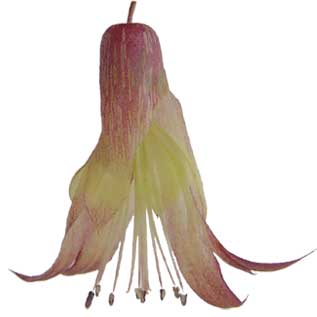ANGELICA - Bryophyllum pinnatum
Botany
A rapid growing juicy herb. Leaves are thick, fleshy and simple or compound in pairs on reddish stems.
Plantlets grow along the notches of the leaf margins which can develop while still attached to the plant or when detached, a fascinating characteristic that earns its name.
Flowers are about 5 cm long, nodding, dangling and bell-shaped, greenish or yellowish, reddish by the stems.

Distribution
Easily propagated and widely distributed in the Philippines, found in thickets and open places. Also cultivated, flowering from December to March. Probably of prehistoric introduction.
Chemical constituents and properties
• Phytochemical evalutation of leaf extract yielded bryophyllum A, B and C, a potent cytotoxic bufadienolide orthoacetate.
• Bufadienolide has been reported to be poisonous with digitalis-toxicity type cardiac effects (slowing of heart rate, heart blocks and potentially fatal ventricular arryhthmias.
• Bryophillin A, a bufadienolide compound, has shown anti-tumor promoting activity.
Parts utilized
Entire plant. May be collected year round; preferably used fresh.
Uses
Folkloric
Pounded fresh material is applied as a poultice for a variety of conditions: Sprains, eczema, infections, burns; carbuncle and erysipelas. Usually not taken internally.
For boils, the whole leaf is pressed by hand, to and fro, until it becomes moist with the leaf extract. A small opening is made in the middle of the leaf which is then placed on the boil with hole over the pointing of the abscess.
Studies
• Depressant: Neuropharmacological Effects of Aqueous Leaf Extract of Bryophyllum Pinnatum in Mice: Study revealed CNS depressant activity of the aqueous leaf extract that could be due to the presence of bufadienolide.
• Antinociceptive / Anti-inflammatory / Hypoglycemic: Leaf extract study of BP on animals showed it to possess antinociceptive, anti-inflammatory and hypoglycemic properties probably due to the flavonoid, polyphenol and triterpenoid contents.
• Antiulcer: Results of methanolic extract study in rats showed that BP possessed potent antiulcer properties. Leaf extract showed significant reduction in incidence of ulceration in indomethacin-induced gastric ulceration in a dose-dependent manner.
• Tocolytic / Pre-term labor: (1) Study characterized the tocolytic activity of Bp in vitro vs the betamimetic, fenoterol. Results confirmed its tocolytic activity and justifies further clinical studies. (2) Intravenous tocolysis with Bryophyllum pinnatum is better tolerated than beta-agonist application.
• Analgesic: The study concludes that the aqueous extract of BP has strong analgesic potency comparable in a times- and dose-dependent manner to a nonsteroidal anti-inflammatory drug.
• Antileishmanial: The antileishmanial activity assessment of unusual flavonoids from Kalanchoe pinnata: Quercetin from K pinnata has demonstrated to be a potent antileshmanial flavonoid. Another study yielded unusual flavonoids with antileishmanial effect.
• Cytotoxic: A study isolated a potent cytotoxic bufadienolide orthoacetate and identified as bersaldegenin 1,3, 5-orthoacetate.
• Antimicrobial: Extract of leaves showed activity against all test organisms except for Candida albicans. Of all the extracts of Bp, themethanol extract was the most active with marked antibacterial activities against control strain of S aureus, E faecalis, B subtilis and P aeruginosa.
Availability
Wild-crafted.




Thanks for sharing this informative information about angelica extract with us. It's very helpful. Keep it up!